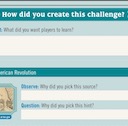Eagle Eye Citizen incorporates assessment tools into the challenges themselves to better facilitate evaluating student learning. Student reflections and track their progress over time, and rubrics assess critical thinking and primary
.



After solving or creating a challenge, students observe, question, and reflect on their choices. These responses can be used by teachers as a formative assessment toward a lesson or unit’s learning goals.
Solving a challenge: After solving a challenge, students are asked to identify and note primary source details, generate hypotheses about the sources, consider further questions, and reflect on what they learned by completing the challenge. They can look closely at each source as they reflect by clicking the link to the Library of Congress. They are prompted to answer the following questions:
- What did you notice first?
- What did you see when you looked closely at each source?
- What else do you want to know?
- What did you learn?
Creating a challenge: After creating a challenge, students explain what their challenge was designed to teach. They will be asked why they chose each particular source and clue. Using these responses you can evaluate students’ rationales for their choices and determine their progress toward learning content and skills. They are prompted to answer the following questions:
- What did you want players to learn?
- Why did you pick this source?
- Why did you pick this clue?
Students answer the reflection questions after every challenge, allowing you to track student thinking and progress over time. For each class, these reflections will be accessible in the Teacher Dashboard only and are not made public.
Rubrics emphasize critical thinking and primary source analysis as students solve and create challenges.
General Rubrics: The following rubrics can be used to assess student learning in solving or creating any challenge and as templates to highlight specific content and skills.
Solving a Challenge Rubric (general): This rubric assesses student learning in solving any challenge.
Creating a Challenge Rubric (general): This rubric assesses student learning in creating any challenge.
Challenge-specific Rubrics: These rubrics can be used to assess student learning in creating specific challenge types.
Creating a Time After Time Challenge Rubric: This rubric is designed to assess the specific skills involved in creating a Time After Time challenge, including periodization and sequencing.
Creating a Sort It Out Challenge Rubric: This rubric is designed to evaluate the categorization and contextualization skills involved in creating a Sort It Out challenge.
Creating a Big Picture Challenge Rubric: This rubric assesses the primary source analysis skills involved in creating a Big Picture challenge.
To encourage student interest, ranks and badges are available to earn. View the Achievements section to learn more.